Welcome to our comprehensive beginner’s guide on using Water Wisteria, or Hygrophila Difformis, in your aquascaping endeavors.
Whether you’re new to aquascaping or looking to enhance your aquarium, Water Wisteria is a fantastic choice for its beauty and ease of care.
In this guide, we will delve into the origins of Water Wisteria, its care requirements, propagation techniques, and more.
Join us as we explore the captivating world of Water Wisteria and discover how it can transform your aquatic habitat.
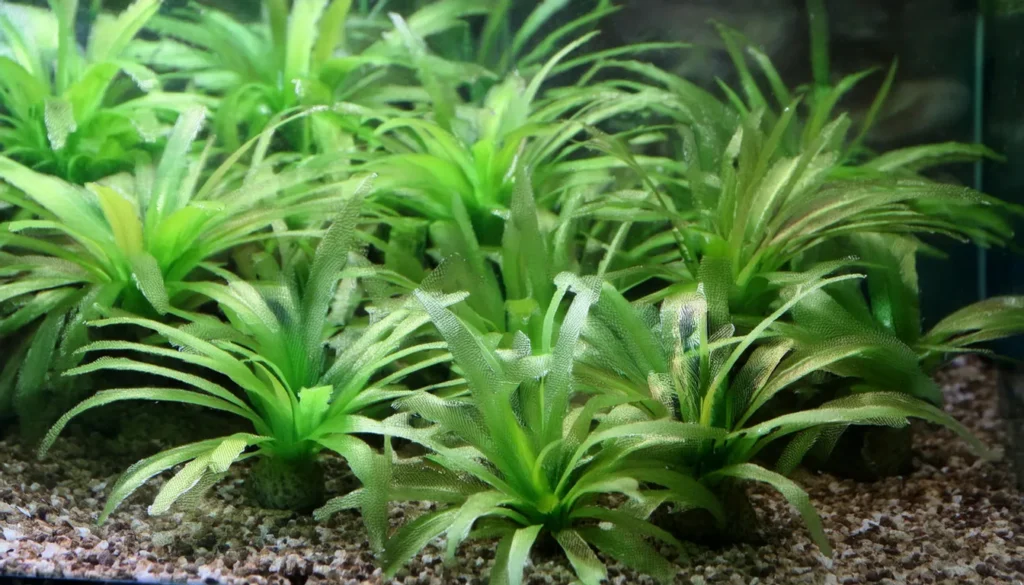
Key Takeaway
- Water Wisteria, also known as Hygrophila Difformis, is a popular aquarium plant used for aquascaping.
- It is a great choice for beginners due to its beauty, ease of care, and ability to enhance the tranquility of your aquarium.
- Water Wisteria has a unique foliage and growth pattern that adds an aesthetic appeal to any aquascape.
- Understanding the lighting requirements and water temperature ranges is crucial for maintaining healthy conditions for Water Wisteria.
- Providing the right nutrients, substrate, and supplemental fertilizers or CO2 can ensure the optimal growth of Water Wisteria.
Quick Stats
| Attribute | Details |
| Family Name | Acanthaceae |
| Origin | Indian Subcontinent |
| Height | 20-50 cm (8-20 inches) |
| pH Range | 6.5 – 7.5 |
| CO2 Requirement | Low |
| Growth Rate | Fast |
| Care Level | Easy |
| Color Form | Green, with deeply cut, feathery leaves |
| Water Conditions | 22-28°C (72-82°F), adaptable to a range of water hardness |
| Max Size | Can grow up to 50 cm (20 inches) tall, often trimmed shorter in aquariums |
| Lighting | Moderate to High |
| Supplements | Benefits from liquid fertilizers; CO2 supplementation is optional but can enhance growth |
| Placement | Background or Mid-ground |
| Propagation | Stem cuttings |
What Are Water Wisteria?
Water Wisteria, scientifically known as Hygrophila Difformis, is a stunning aquatic plant that brings beauty and tranquility to your aquarium.
Its delicate leaves and graceful growth pattern make it a popular choice among aquascapes.
This versatile aquatic plant is not only visually appealing but also offers numerous benefits for beginners in the world of aquascaping.
RELATED: Unveiling Heteranthera Zosterifolia Planting Tips For Beginners
Natural Habitat And Origin
Water Wisteria (Hygrophila difformis) is native to the Indian subcontinent and parts of Southeast Asia.
It is commonly found in freshwater habitats such as ponds, lakes, marshes, and slow-moving streams with moderate water flow.
In its natural habitat, Water Wisteria grows submerged or partially submerged along the banks of water bodies, often forming dense stands of vegetation.
The plant thrives in tropical and subtropical climates, where it can receive ample sunlight and access to nutrient-rich water.

Physical Characteristics
- Leaves: The leaves of Water Wisteria are typically ovate to lanceolate in shape and can vary in size, with mature leaves reaching lengths of 2 to 5 centimeters (0.8 to 2 inches). The leaves are arranged alternately along the stems and have finely toothed margins.
- Foliage: The foliage of Water Wisteria is lush and dense, with multiple stems emerging from a central root system. The plant forms bushy clusters of foliage that can provide ample cover and habitat for fish and other aquatic organisms.
- Coloration: The foliage of Water Wisteria is typically a vibrant shade of green, adding a pop of color to the aquarium. Under optimal conditions, the leaves may take on a slightly reddish hue, especially in high-light environments.
- Stems: Water Wisteria features slender, branching stems that can grow upright or trail along the substrate, depending on the aquarium’s water flow and lighting conditions. The stems are flexible and can easily adapt to different growth patterns.
- Root System: Water Wisteria develops a robust root system that anchors the plant in the substrate and absorbs nutrients from the water column. The roots may extend deep into the substrate, helping to stabilize the plant and promote healthy growth.
Lighting Requirements For Optimal Growth
- Water Wisteria has specific lighting requirements that are crucial for its optimal growth. This aquatic plant thrives under moderate to high lighting conditions.
- Providing your Watthat you Wisteria with water wisteria of light per day is recommended.
- Full-spectrum LED or fluorescent lights are highly recommended to ensure your plants receive the right light wavelengths for photosynthesis.
- By fulfilling the lighting needs of your Hygrophila Difformis, you can promote lush and healthy foliage growth, enhancing the beauty of your aquascape.
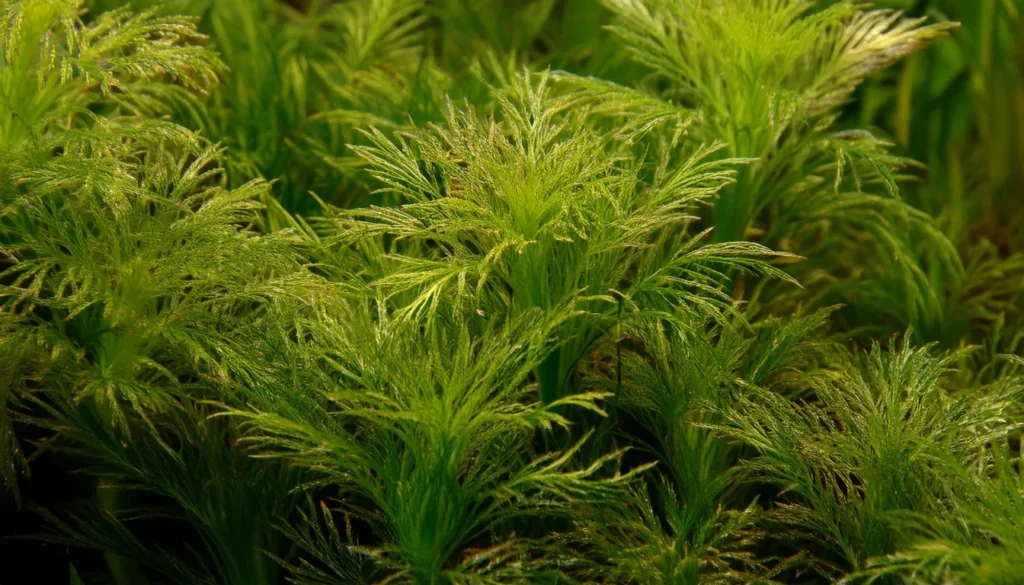
Temperature Parameters
- Temperature Range: Water Wisteria can tolerate temperatures between 20°C to 28°C (68°F to 82°F). This encompasses the typical temperature range found in most tropical freshwater aquarium setups.
- Optimal Temperature: The ideal temperature for Water Wisteria growth falls within the mid-range of this spectrum, typically between 24°C to 26°C (75°F to 79°F). At this temperature, the plant exhibits robust growth and vibrant coloration.
- Temperature Stability: While Water Wisteria can tolerate fluctuations in temperature to some extent, it thrives best in conditions where temperatures remain stable. Sudden or drastic changes in temperature can stress the plant and compromise its health.
- Heating and Cooling: Use aquarium heaters to maintain stable temperatures within the recommended range, especially during cooler months or in colder climates. Conversely, ensure adequate cooling measures, such as aquarium fans or chillers, during warmer months to prevent overheating.
Water Temperature Ranges For Hygrophila Difformis
- Controlling the water temperature is crucial for the well-being of your Water Wisteria. Hygrophila Difformis thrives in water temperatures ranging from 72°F to 82°F (22°C to 28°C).
- It is important to avoid extreme temperature fluctuations, as it can stress the plants and hinder their growth. Maintaining a stable and suitable water temperature within this range provides the optimal conditions for your Water Wisteria to grow and flourish.
- Creating healthy conditions for your Hygrophila Difformis is essential for optimal growth and overall well-being. By ensuring the right lighting and maintaining the appropriate water temperature, you can provide an environment that promotes the thriving of your Water Wisteria.
RELATED: Cultivating Hemianthus Micranthemoides (Pearl Weed) For A Versatile Aquatic Oasis
Substrate Requirements
- Nutrient-Rich Substrate: While not strictly necessary, planting Water Wisteria in a nutrient-rich substrate can promote healthy growth and vibrant foliage. Substrates specifically formulated for planted aquariums, such as aquasoil or nutrient-rich gravel, provide essential nutrients that can be absorbed by the plant’s roots.
- Fine-Grained Substrate: Water Wisteria can be planted in fine-grained substrates such as sand or fine gravel. These substrates allow the plant’s roots to penetrate easily and anchor the plant securely while providing stability for the stems.
- Depth: Ensure that the substrate depth is sufficient to accommodate Water Wisteria’s root system. A substrate depth of at least 2 to 3 inches (5 to 7.5 centimeters) is recommended to provide ample space for root development and stability.
- Substrate Fertilization: Consider supplementing the substrate with root tabs or fertilizer pellets to provide additional nutrients for Water Wisteria. These substrate fertilizers slowly release nutrients into the root zone, supporting healthy growth and vitality.
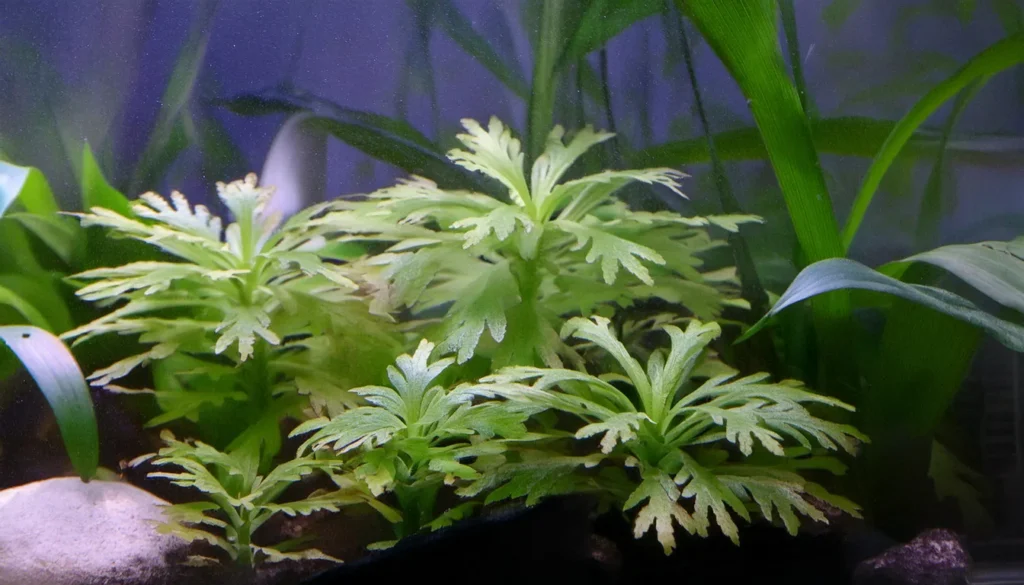
Placement Options
- Background Planting: Water Wisteria can be placed in the background of the aquarium, where its tall stems and lush foliage can serve as an attractive backdrop for other plants and aquarium decor. Planting it towards the rear corners or sides of the tank helps create depth and visual interest.
- Midground Planting: Alternatively, Water Wisteria can be placed in the midground of the aquarium, adding height and texture to the middle portion of the tank. This placement option works well for larger aquariums, where the plant’s full growth potential can be showcased without overshadowing foreground plants.
- Foreground Accent: While Water Wisteria is typically considered a background or midground plant, it can also be used as a foreground accent in smaller aquariums. Trimmed stems or smaller specimens can be strategically placed in the front corners or along the edges of the tank to add depth and dimension to the aquascape.
Recommended Tank Size
- Small Tanks: Water Wisteria can be successfully grown in small aquariums, such as nano tanks or tanks with capacities as low as 5 gallons (19 liters). In smaller tanks, consider planting fewer stems and regularly trimming the plant to prevent overcrowding.
- Medium Tanks: For medium-sized aquariums ranging from 10 to 30 gallons (38 to 114 liters), Water Wisteria can be used as a background or midground plant to add height and texture to the aquascape. Planting several stems along the back or sides of the tank can create a lush backdrop.
- Large Tanks: In larger aquariums exceeding 30 gallons (114 liters), Water Wisteria can be planted more liberally to fill in empty spaces and provide habitat for fish and other aquatic inhabitants. Consider using Water Wisteria as part of a diverse planted layout, incorporating it with other plant species for a dynamic and visually appealing aquascape.
- Community Tanks: Water Wisteria is suitable for community aquariums housing a variety of fish species. When selecting a tank size for a community setup, ensure that the tank provides ample space for both the plants and the fish to thrive. A larger tank size, such as 20 gallons (76 liters) or larger, is generally recommended for community setups to accommodate multiple fish species and minimize territorial conflicts.
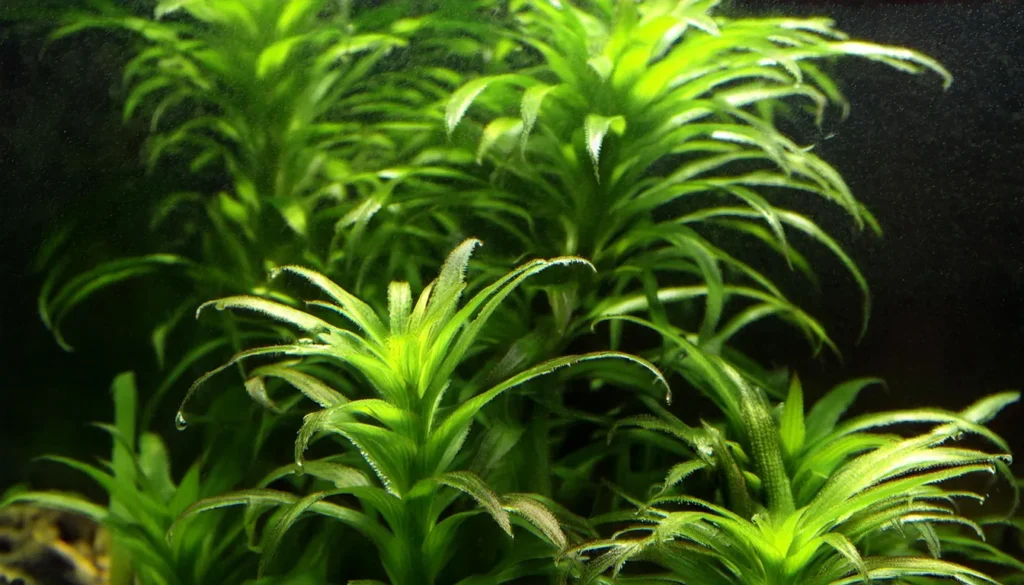
Compatible Aquatic Species For Water Wisteria
When selecting companion fish for your Water Wisteria aquarium, it is essential to consider their compatibility with this aquatic plant.
Certain species are known to peacefully coexist with Water Wisteria, creating a visually stunning and harmonious arrangement. Some compatible species include:
- Tetras
- Guppies
- Platies
- Corydoras Catfish
- Otocinclus Catfish
- Cherry Shrimp
Nutritional Needs Of The Plant
- Macronutrients: Water Wisteria requires three primary macronutrients—nitrogen (N), phosphorus (P), and potassium (K)—for robust growth. These macronutrients are essential for various physiological processes, including photosynthesis, cell division, and root development. Macronutrients can be supplied to the plant through the substrate, water column, or fertilization.
- Micronutrients: In addition to macronutrients, Water Wisteria also requires micronutrients, albeit in smaller quantities. Micronutrients include elements such as iron (Fe), manganese (Mn), zinc (Zn), copper (Cu), boron (B), molybdenum (Mo), and chlorine (Cl), among others. These micronutrients play vital roles in enzyme activation, chlorophyll synthesis, and overall plant health.
- Carbon Dioxide (CO2): Like most aquatic plants, Water Wisteria utilizes carbon dioxide (CO2) during photosynthesis to produce carbohydrates and oxygen. While Water Wisteria can obtain CO2 from the surrounding water, supplementing with additional CO2 through injection or natural methods can enhance growth and vitality, especially in high-light setups.
Water Wisteria Cultivation Tips
- Lighting: Provide moderate to high-intensity lighting for water wisteria. This plant can adapt to a wide range of light intensities, but stronger lighting will encourage more compact growth and vibrant coloration. Aim for a photoperiod of 8 to 10 hours per day.
- Water Parameters: Water wisteria is adaptable to various water parameters, but it generally thrives in slightly acidic to alkaline water with a pH range of 6.5 to 7.5 and a temperature range of 22°C to 28°C (72°F to 82°F). Maintain stable water parameters to prevent stress and promote healthy growth.
- Substrate: Plant water wisteria in a nutrient-rich substrate to encourage healthy root growth and nutrient uptake. Fine-grained substrates like aquasoil or nutrient-rich substrates specifically formulated for planted tanks are ideal. Ensure a substrate depth of at least 2 to 3 inches (5 to 7.5 centimeters) to accommodate root development.
- CO2 and Fertilization: While not always necessary, supplementing with CO2 and liquid fertilizers can enhance the growth of water wisteria, especially in high-tech planted aquarium setups. CO2 supplementation promotes vigorous growth, while liquid fertilizers provide essential nutrients like nitrogen, phosphorus, and potassium.
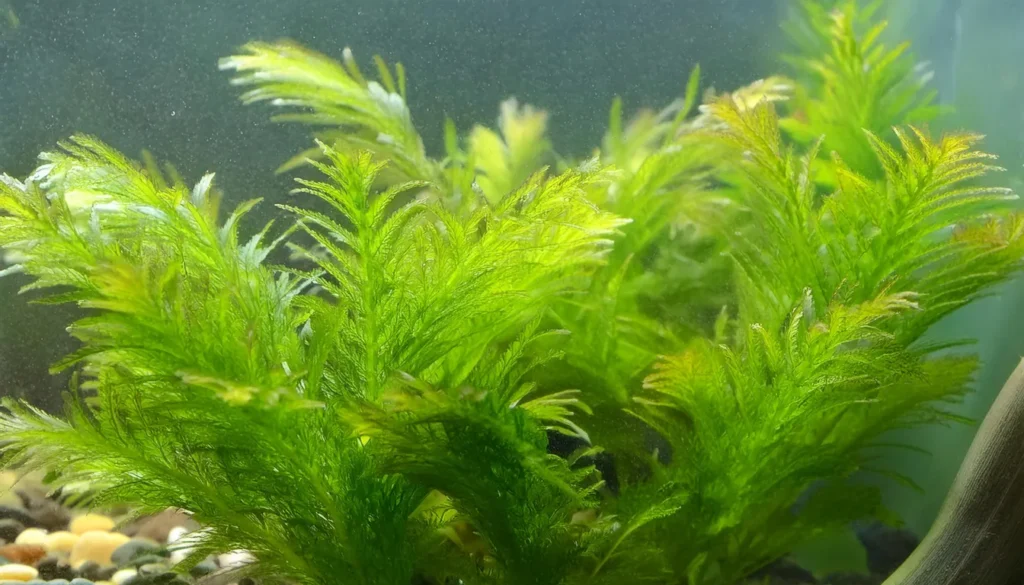
Plant Propagation Tips
- Identify Healthy Stems: Select healthy stems with several leaves and no signs of damage or decay for propagation. Look for stems that are vibrant green and free from pests or algae growth.
- Prepare Cuttings: Using sharp, clean scissors or aquascaping tools, trim the selected stems just below a leaf node. Aim for stem cuttings that are approximately 2 to 4 inches (5 to 10 centimeters) in length. Remove any leaves from the lower portion of the cutting to expose the nodes.
- Plant Cuttings: Plant the stem cuttings directly into the substrate of the aquarium. Insert the cuttings at an angle to bury the node in the substrate while keeping the leaves above the surface. You can use planting tweezers to gently press the cuttings into the substrate for stability.
- Provide Optimal Conditions: Ensure that the propagated cuttings are provided with optimal conditions for rooting and growth. This includes adequate lighting, nutrient supplementation, and stable water parameters. Maintain moderate water flow to prevent stagnation around the cuttings.
Benefits Of Planting Wisteria
- Natural Filtration: Water Wisteria helps improve water quality by absorbing excess nutrients such as nitrates, nitrites, and ammonia from the water column. This natural filtration process helps maintain a healthy and balanced aquatic ecosystem.
- Oxygenation: Like all aquatic plants, Water Wisteria contributes to oxygenation of the aquarium water through photosynthesis. During daylight hours, the plant absorbs carbon dioxide and releases oxygen, helping to oxygenate the water and provide a healthier environment for fish and other aquatic inhabitants.
- Algae Control: Water Wisteria competes with algae for nutrients in the water column, helping to reduce algae growth and maintain water clarity. By outcompeting algae for nutrients, the plant can help prevent algae blooms and keep the aquarium looking clean and vibrant.
- Habitat and Shelter: Water Wisteria provides shelter and hiding places for fish, shrimp, and other aquatic organisms. The dense foliage and branching structure of the plant offer refuge for shy or territorial fish and provide a naturalistic habitat for them to explore and forage.
- Aesthetic Enhancement: With its lush green foliage and graceful, trailing growth habit, Water Wisteria adds beauty and visual interest to the aquarium. The plant can be used to create a naturalistic aquascape, provide contrast with other plants, or serve as a focal point in the tank
Conclusion
This comprehensive guide has provided all the information you need to incorporate Water Wisteria into your aquascaping endeavors successfully.
We have explored the beauty and tranquility that Hygrophila Difformis brings to your aquarium and why it is a perfect choice for beginners in the world of aquascaping.
You now clearly understand the importance of creating healthy conditions for the optimal growth of Water Wisteria, including the lighting requirements and water temperature ranges.
We have also discussed the significance of selecting and supplementing the right substrate with fertilizers and CO2 to nourish your plants.
Furthermore, we have provided insights into pruning and propagating Water Wisteria, enabling you to maintain your plants’ desired shape and size and expand your collection.
We have also explored the harmony between Water Wisteria and companion fish, ensuring a balanced ecosystem.
Lastly, we discussed the role of filters and CO2 systems in maintaining an ideal environment for the well-being of Hygrophila Difformis.
With this knowledge in hand, we encourage you to embrace the elegance and charm of Water Wisteria in your aquarium.
By incorporating this beautiful aquatic plant into your aquascape, you can create a thriving environment that brings joy to both you and your aquatic inhabitants.
Happy aquascaping with Water Wisteria and Hygrophila Difformis!
Frequently Asked Questions
Should I Supplement Water Wisteria With Fertilizers And Co2?
Supplementing with fertilizers and CO2 can greatly benefit the growth of Water Wisteria.
A balanced liquid fertilizer and a CO2 system can provide nutrients and carbon dioxide to promote healthy growth and vibrant foliage.
How Do I Prune Water Wisteria?
To maintain the desired shape and size of Water Wisteria, you can prune the plant by cutting the stems or removing excessive growth.
It is best to use sharp scissors or pruning tools to ensure clean cuts and prevent damage to the plant.
How Can I Propagate Water Wisteria?
Propagating Water Wisteria can be done by cutting off healthy side shoots or stem cuttings and replanting them.
Simply plant the cuttings in the substrate, ensuring they have proper root growth and access to light and nutrients.
Which Aquatic Species Are Compatible With Water Wisteria?
Water Wisteria is compatible with many aquatic species and can coexist peacefully in an aquarium.
Fish species such as tetras, gouramis, rasboras, shrimp, and snails are known to thrive alongside Water Wisteria.
How Do Filters And Co2 Systems Contribute To Maintaining An Ideal Environment For Water Wisteria?
Filters help maintain optimal water quality by removing debris, toxins, and excess nutrients from the aquarium, ensuring a healthy environment for Water Wisteria.
CO2 systems provide essential carbon dioxide to support plant growth and photosynthesis.
- Unveiling The Wonders Of Riccia Fluitans In Aquascapes - August 7, 2024
- Vallisneria Gigantea Var. Guide To Care And Cultivation At Home - July 31, 2024
- Vesicularia Dubyana Care & Growth Guide Tips For Beginner Gardeners - July 30, 2024
